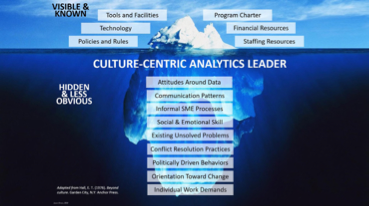5 Tips for Implementing a Data and Analytics Culture

When I hear “data and analytics culture,” I immediately think of the work Jason Simon and his team are doing at the University of North Texas (UNT). Jason Simon, Ph.D., Associate Vice President of Data, Analytics and Institutional Research (DAIR), leads a team of twelve with a broad array of institutional research, business intelligence, data modeling and data governance experience.
When I initially met Simon several years ago, he explained that UNT had fundamental issues with data integrity, data management, and data governance, which plagued the university’s analytics department, relegating data to silos and made enterprise analytics difficult.
Given UNT’s more than 5,000 employees and countless stakeholders, Simon recognized his task went far beyond organizing data to meet executives’ needs. There were so many important factors to take into account—attitudes about data, communication norms, and politics, to name just a few. Data are just an obvious factor. So many other factors lie below the waterline, so to speak.

Source: Building an Analytical Culture for Success | SAS
You have to address the visible and known elements, but to succeed, you have to focus on the cultural factors below the waterline.
With this important recognition, Simon and his team engaged their anthropology faculty to conduct research that might inform their project. Together they asked, “What would an ideal data landscape look like in an institution of higher education?”
I was curious about what best practices UNT could share from their journey instituting a data and analytics culture, and here’s what they shared:
- Assess current resources and skillsets within the organization. How can others—even beyond the analytics department—contribute to the data governance ecosystem? Leveraging the expertise among, say, faculty or the communications department, will not only improve data outcomes, but it will also involve a wider audience earlier in valuing and understanding data.
- Step back and ask what your institution needs from you as a data leader through stakeholder interviews. Then build a comprehensive plan that will fulfill those needs—a plan that includes resources, staffing, platforms, training, etc.
- Monitor and document questions to the IR office about what something means, as these questions represent an area of curiosity for the campus community but are also a distraction for the IR team from more critical research.
- Establish goals and thresholds for success at the beginning of the process. What does good look like, and how will you know you’ve achieved it? We must practice what we preach. So the program roadmap should be evidence-based, including KPIs (perhaps related to training, a finalized data dictionary, platform completion), any relevant revenue returns, etc.
- Track all quantifiable cost savings and ROI, including improvements in time savings, productivity, and operational efficiencies by business units. Proactively share results along the way so leadership recognizes the value a culture of data governance and analytics adds to the organization. Provide executives with new reports that influence decision-making and give them success stories they can evangelize.
Since building a strong data and analytics culture, with the help of SAS, increased efficiencies at the university have led to cost reductions of more than $1 million. You can be sure Simon shared that with his leadership as proof of value.
The team added one more tip for good measure: Be prepared to pivot, as data and expectations are always changing.
It was great to catch up with Simon. Hopefully the experiences he and his team have shared will benefit other institutions embarking on a similar journey of implementing a data and analytics culture.
To learn more about UNT’s journey building a data culture, download Building an Analytical Culture for Success | SAS or watch videos from this YouTube Playlist: University of North Texas: Establishing a Culture of Analytics.
This article originally appeared on a SAS blog post.
 Georgia Mariani has spent nearly a quarter century exploring and sharing how analytics can improve outcomes. As a Principal Industry Marketing Manager at analytics leader SAS, supporting the education industry, she passionately showcases customers using analytics to tackle important education issues and help students succeed. Georgia received her M.S. in Mathematics with a concentration in Statistics from the University of New Orleans.;
Georgia Mariani has spent nearly a quarter century exploring and sharing how analytics can improve outcomes. As a Principal Industry Marketing Manager at analytics leader SAS, supporting the education industry, she passionately showcases customers using analytics to tackle important education issues and help students succeed. Georgia received her M.S. in Mathematics with a concentration in Statistics from the University of New Orleans.;
